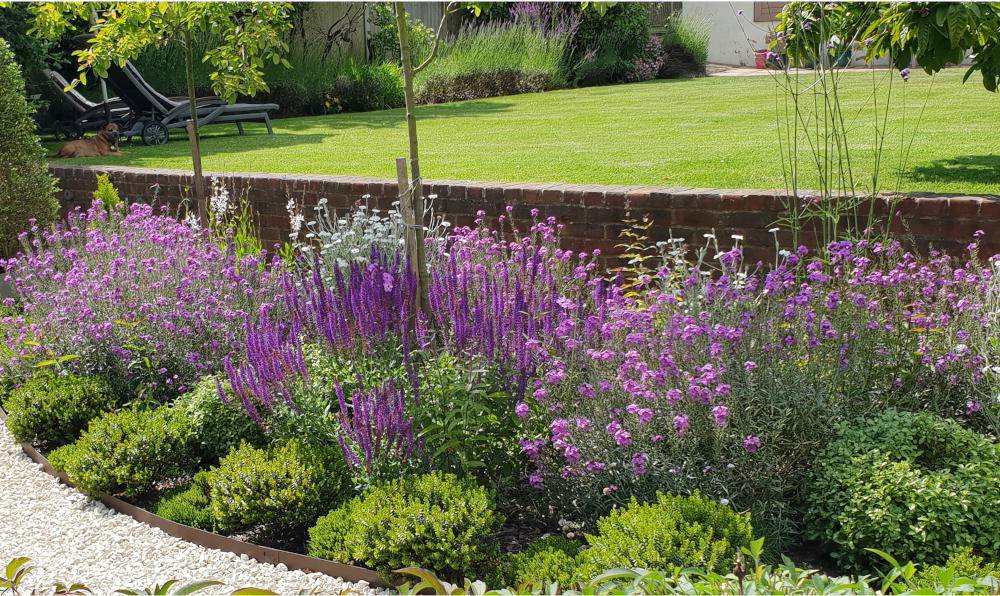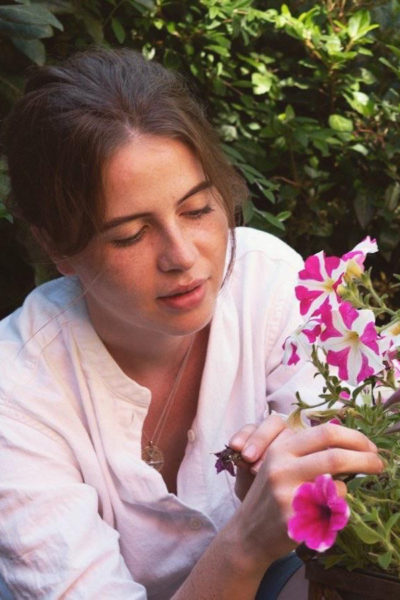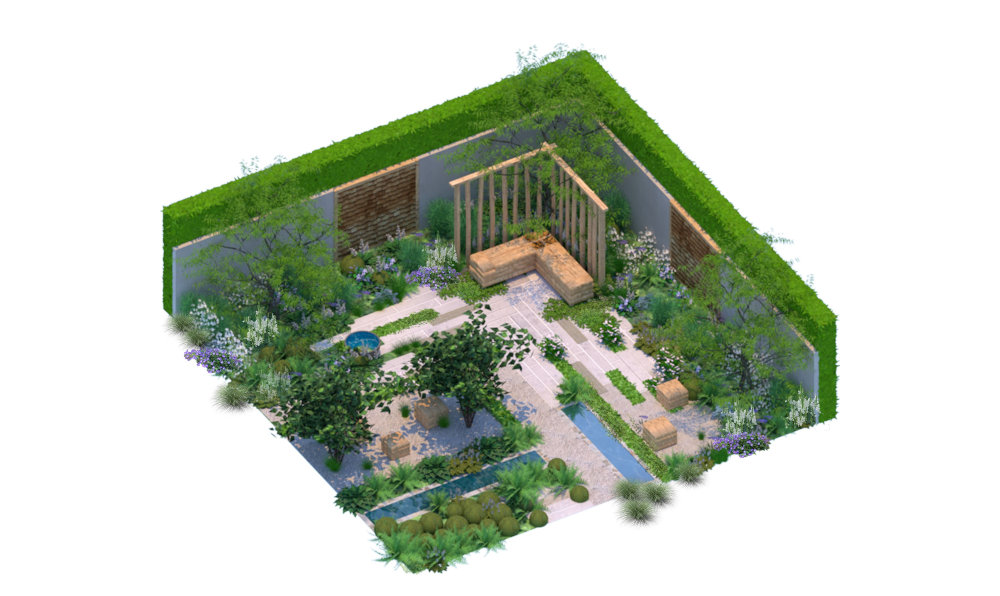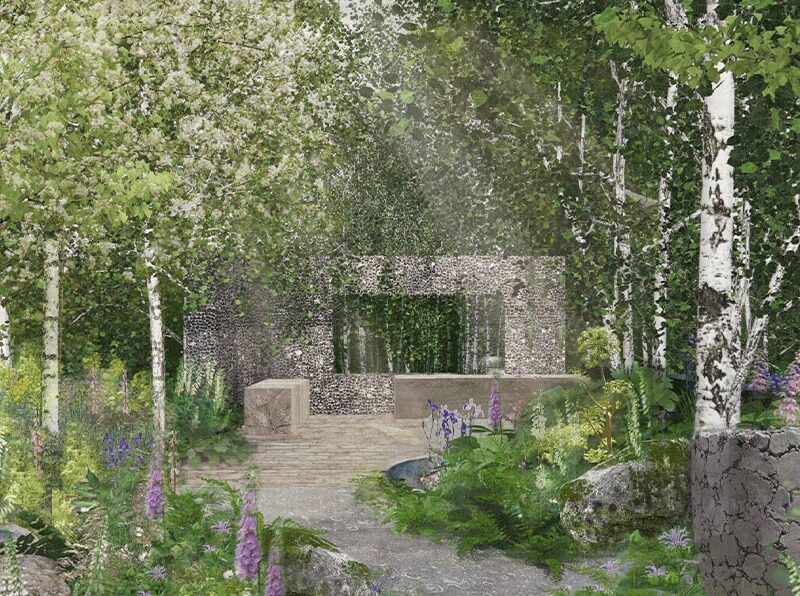
Summer Garden Colour Pops
SUMMER GARDEN COLOUR POPS
Garden designer Amelia Bouquet reveals how to add vibrancy to your outdoor space this summer…
Featured image: www.ameliabouquetgardendesign.com
Bright colours in the garden are always an uplifting sight and can create a big impact in your outdoor space during the summer months.
If you are looking for summer long colour with reliability and have a good amount of sun, then I would recommend using salvias. There are many different species of salvia and they come in nearly every colour you can imagine.
A go-to option for a regal purple in the garden is Salvia nemorosa ‘Caradonna’ or if you are looking for height in your borders then Salvia ‘Amistad’ is a winner. Some beautiful pink salvias include, Salvia greggi ‘Pink Preference’, a lovely cultivar with delicate nodding pink flowers and Salvia nemorosa ‘Caradonna Pink Inspiration’ with gorgeous spires of pink.

If you have a shadier garden but are still craving some vibrancy, then I would recommend using hardy geraniums. They are long-flowering perennials that are relatively fuss free. For a dazzling blue try Geranium ‘Johnson’s Blue’, the colour is also particularly attractive to pollinators!
Another way of incorporating bright colour into shadier gardens is to use perennials with vibrant foliage. Heucheras are well suited to shade and really brighten up a border. Try cultivars such as ‘Lime Marmalade’ or ‘Key Lime Pie’ near the front of your flower bed.
For colourful perennials that give a more sculptural feel to your planting schemes, then I would recommend using Echinops bannaticus ‘Blue Globe’ which has a very distinctive spherical form to its flowers similar to that of alliums in shape. A delightful and colourful companion to Echinops is Echinacea purpurea ‘Magnus’. Both plants together create a hugely impactful and cheerful addition to any border, and again a haven for pollinators
Another beautiful prairie-style plant with rich deep colour is Sanguisorba officinalis, the rich maroon flowers will flower late summer through to autumn.
When adding colour to the garden, try to think of the background plants you can use to make the colourful perennials stand out even more. Using a good backdrop of evergreen shrubs or less showy perennials is a good way of ensuring the stars of the show really take centre stage. Herbaceous perennials such as Alchemilla mollis are a great ‘filler plant’ and create a green stage for colours to pop against and compliment.
Copyright RHS
Ornamental grasses can be a bit of a divider, some people love them and some people hate them. But they are an interesting way to add swathes of colour throughout the garden with long-lasting effect and interest in winter. Panicu virgatum ‘Shenandoah’ is an impactful grass with vibrant red tips. Imperata cylindrica ‘Red Baron’ is also another vivacious grass that gives drama, colour and structure.
Using colour at different heights through the use of trees is also a way of creating continuous bursts of colour in the garden. Ceanothus is a great tree or shrub to plant for both evergreen structure and beautiful blue clusters of flowers in late spring and early summer with a heavenly scent. Not all Ceanothus are evergreen, so best to check the label! Rambling roses for vertical and lateral colour, if you have the room, create an impressive display of flowers. Try David Austen’s Rosa ‘Crimson Shower’, a gorgeous rambler with crimson flowers.
Most importantly when thinking of adding colour to the garden, take into consideration what kind of soil you have, how much sun you get and how much maintenance you are willing to put in before purchasing your plants.
Colour is possible in both shade and sun but it requires a bit of investigation and observation prior, to ensure that you get the best results.
Power of Plants
See Amelia’s beautiful work at the RHS Hampton Court Palace Garden Festival…

Amelia has designed The Communication Garden for the Festival, which returns this year from 5 – 11 July.
The garden, in support of Mental Health UK, is designed as a symbolic refuge and a living, growing one. It is a place to meet, talk, listen and to highlight the importance of face to face communication for our mental wellbeing in a world where more and more people use technology to communicate.
Rustic woodland planting and native trees provide a protective canopy while encouraging us to look up and beyond. A main feature screen signifies the nucleus of the garden determining all the shapes in the space, representing the way that all our ways of communicating start with a single thought. Meanwhile a partly a secluded seating area draws the visitor in along fractured pathways and provides a safe place for ideas to ebb and flow.
As you move through the garden, the planting becomes more wild and relaxed as you unwind.
The planting scheme consists of many shades of green, light pink, purple and blue. Key plants include Melica uniflora f. albida; Geranium sanguineum ‘Vision Light Pink’ (Vision Series); Deschampsia cespitosa; and Kalimeris incisa ‘Blue Star’. Large statement ferns will be used to contrast with more delicate flowering perennials such as Physostegia virginiana ‘Summer Snow’ – a less used perennial, astrantia and tradescantia.






